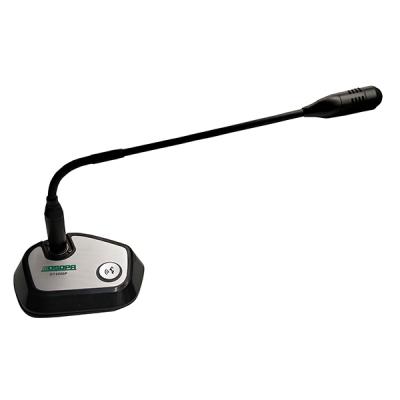

Leave a message

In the conference room, the voice should be bright and clear, and the loudness should be moderate. It is impossible for the speaker to audition on the spot when the meeting room is being arranged. Therefore, if we want to achieve a bright and clear sound effect (loudness is just right but it can not produce sound feedback) when amplifying sound on the spot, there is certain knowledge of the selection and placement of conference microphones.
Different conference microphones have different effects on different sound sources, so before choosing a microphone, we must have a thorough understanding of its technical characteristics, performance and applicable occasions. In the selection of microphone, besides the sensitivity of microphone, the matching of output impedance and input impedance of mixer, the directional characteristics, frequency response characteristics and shape of microphone should also be considered in the conference room.
As far as directivity is concerned, super-heart shape is suitable for long-distance pickup, heart shape is suitable for most situations, and non-direction is not suitable for language pickup because it prone to reciprocation. In addition, according to the layout of the speakers in the conference room, the microphone with appropriate pointing characteristics should be selected.
1)For centralized or semi-centralized sound amplification systems, the directional characteristics of conference microphones should be heart-shaped or super-heart-shaped.
2)Heart-shaped microphone should be chosen for distributed sound amplification system. If the microphone is far from the sound amplifier box, and the reverberation time in the hall is not too long, directionless microphone can also be chosen.
3)When the sound source is very close to the microphone, the proximity heart-shaped microphone can be eliminated by using technical indicators.
As far as the frequency response characteristics of microphones are concerned, microphones with lower static technical specifications and better transient characteristics are better than those with slightly higher static technical specifications and poor transient characteristics. In addition, the microphone with uniform and smooth response from low frequency to high frequency is better than that with a prominent frequency band, because the prominent part is also the part that can easily produce sound feedback.
As far as the internal structure of microphone is concerned, moving coil microphone is used in general conference room sound reinforcement in the past. In recent years, with the enlargement and widening of conference tables, capacitive goosenneck microphones are now mostly chosen. In this way, when the conference table is relatively wide, the speaker will not be pushed to the table to pick up the voice. In addition, the microphone head of the capacitive microphone is relatively small. It does not cover the speaker's face, which is also one of the reasons.
In summary, besides special requirements, in conference rooms, capacitive goosenneck microphone with wide frequency response, uniform frequency response transmission characteristics, smoothness and low distortion is generally recommended.
 【DSPPA Demo】PAVA8000 EN54 Voice Evacuation SystemNovember 12, 2020Abstract: DSPPA PAVA8000 EN54 Voice Evacuation SystemToday, we are gonna show you a demo about our PAVA8000 EN54 Voice Evacuation System.PAVA8000EN54 Voice Evacuation System can not only support manua...view
【DSPPA Demo】PAVA8000 EN54 Voice Evacuation SystemNovember 12, 2020Abstract: DSPPA PAVA8000 EN54 Voice Evacuation SystemToday, we are gonna show you a demo about our PAVA8000 EN54 Voice Evacuation System.PAVA8000EN54 Voice Evacuation System can not only support manua...view The National Standard Approval Meeting held in BeijingJuly 19, 2019The National Standard Approval Meeting held in BeijingThe approval meeting of the National StandardTechnical standard of public address system engineeringis held in Beijing on July 16, 2019. Xue Chang...view
The National Standard Approval Meeting held in BeijingJuly 19, 2019The National Standard Approval Meeting held in BeijingThe approval meeting of the National StandardTechnical standard of public address system engineeringis held in Beijing on July 16, 2019. Xue Chang...view